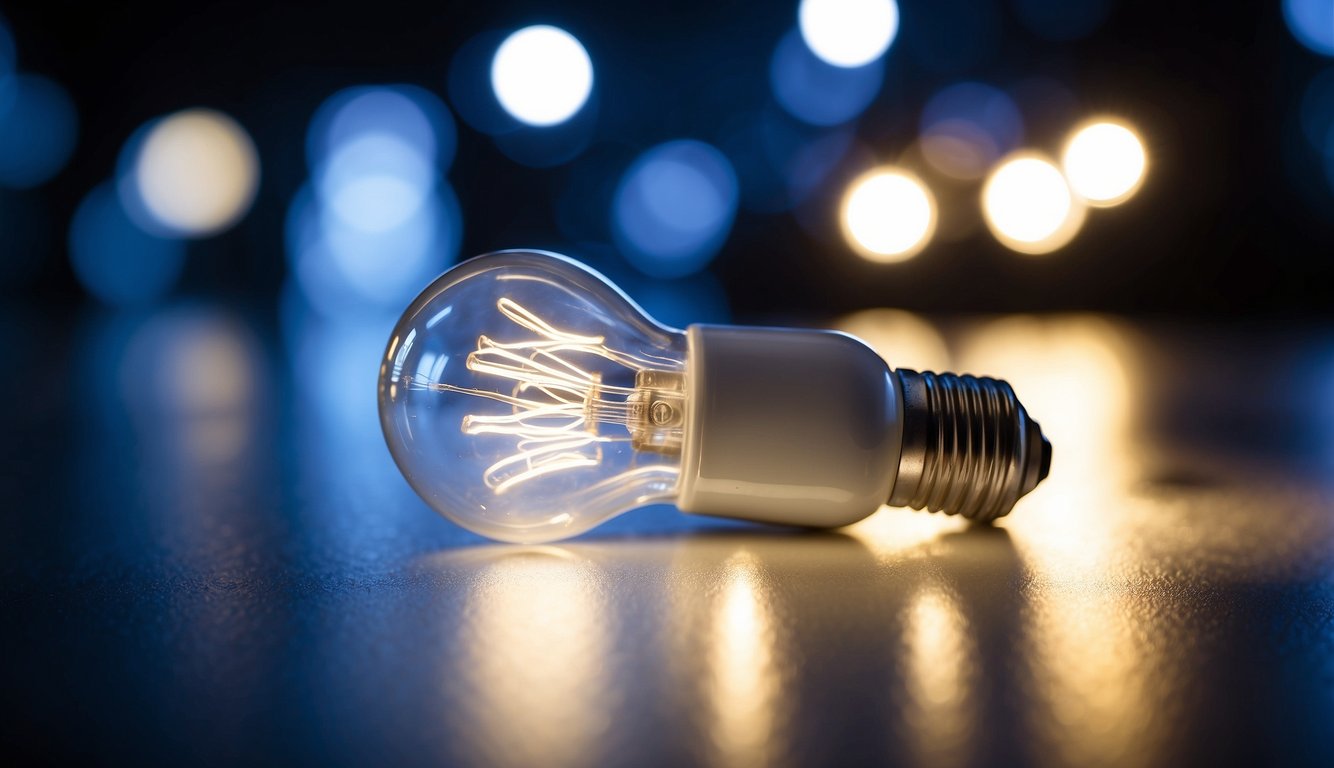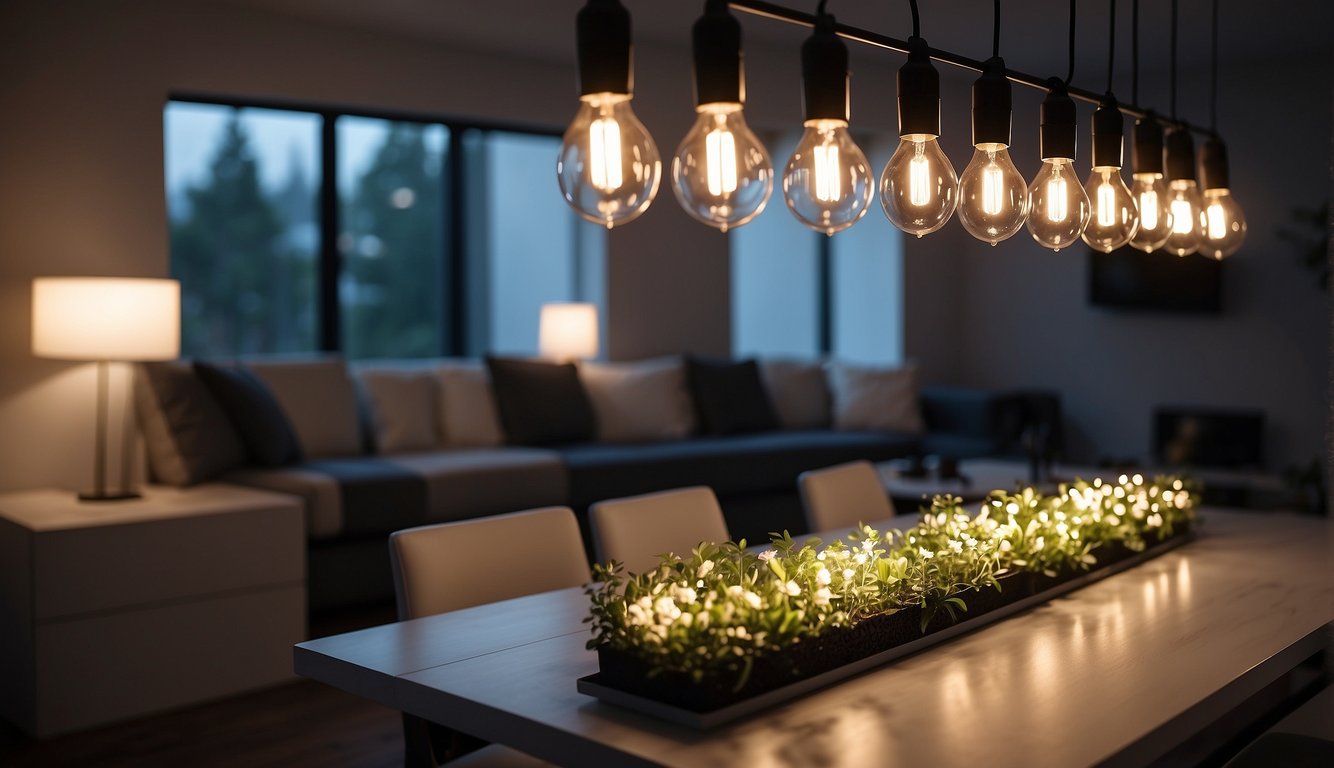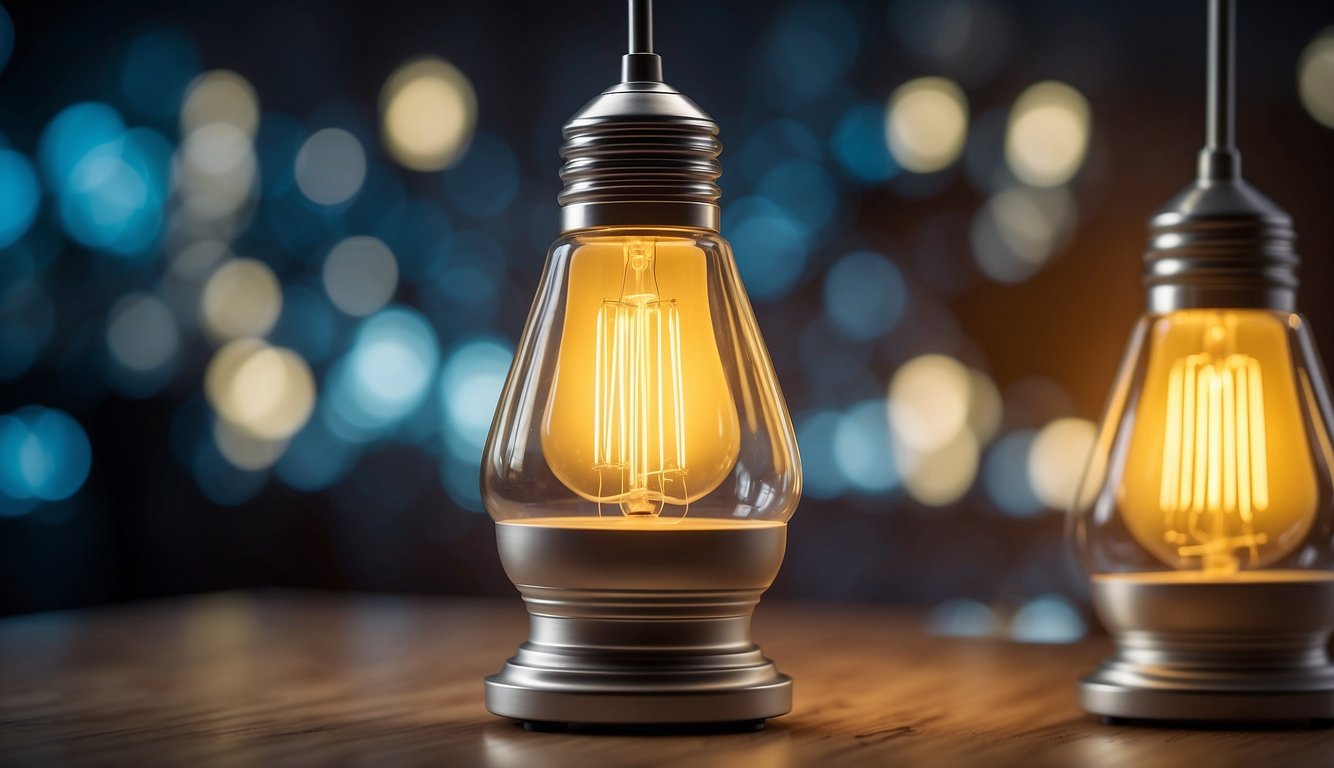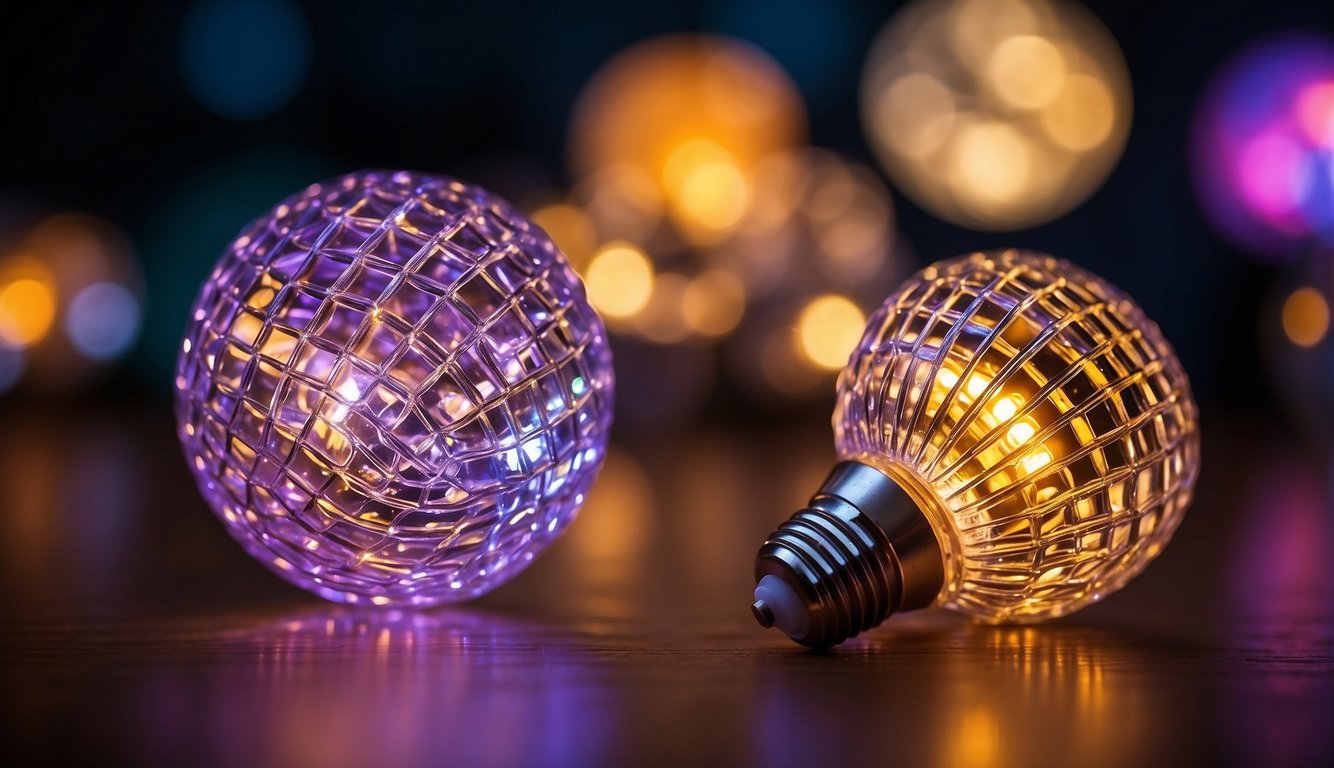Light-emitting diode (LED) light bulbs have revolutionized the way we illuminate our homes and workplaces. As a technology that has seen significant advancements over the years, they are lauded for their energy efficiency and longevity. These bulbs convert a higher percentage of energy into light, making them a more environmentally friendly choice compared to traditional incandescent bulbs. In fact, LED bulbs produce less heat, which translates to better energy utilization and lower running costs.
While the benefits are clear, there’s more to consider when it comes to LED lighting. As a consumer, you must weigh the initial higher purchase cost against the long-term savings on your energy bill. Moreover, there are aesthetic factors at play; the design and brightness of LED lights have evolved to fit various atmospheres and settings. However, it’s important to be aware of the potential sleep disruption caused by the blue light emitted from many LED bulbs, which can impact your circadian rhythm.
Key Takeaways
- LED light bulbs are energy-efficient, producing less heat and offering cost savings.
- Assessing the higher upfront cost against long-term savings is crucial.
- Consider the design versatility and potential health impacts due to blue light emission.
Overview of LED Technology
https://www.youtube.com/watch?v=vDYZxWNDm4k&embed=true

In this section, you’ll discover the essentials behind the workings of LED lights and how they’ve transformed the way we light up our world.
Basic Principles of LED Lights
LED stands for Light Emitting Diode, a type of semiconductor that emits light when electricity is applied. Unlike traditional incandescent bulbs, LEDs don’t have a filament that burns out. Instead, your LED serves as a more efficient light source because electrical current passes through a microchip, illuminating small light sources we call diodes.
Evolution of Lighting Technology
From the first practical incandescent light bulb to the modern LEDs, lighting technology has undergone significant changes. LEDs are a leap forward from past lighting like incandescent or fluorescent lamps because of their longer lifespan and lower energy consumption. Over the years, you’ve seen LEDs advance rapidly, providing brighter and more reliable lighting options across a multitude of applications.
Benefits of LED Light Bulbs
https://www.youtube.com/watch?v=z7ZiLgiuw5Y&embed=true
LED light bulbs have revolutionized the way you light up your home, offering a slew of advantages that not only reduce your energy bills but also contribute to a healthier environment. Let’s explore what makes LED bulbs a smart choice for conscious consumers like you.
Energy Efficiency and Cost Savings
One of the most immediate benefits you’ll notice when switching to LED bulbs is the significant energy efficiency and cost savings. Unlike traditional incandescent bulbs, LEDs use less power to produce the same amount of light, meaning they can save about six times the energy. This efficiency translates directly into savings on your electric bill, as LEDs are estimated to be 80-90% more energy-efficient. Moreover, many governments offer rebates and incentives for LED adoption.
Longevity and Maintenance
Another standout feature of LED bulbs is their long life. While a standard incandescent bulb may last approximately 2,000 hours, an LED bulb can continue to shine for an impressive 75,000 hours or more, depending on usage. This incredible longevity means you won’t be replacing your bulbs as often, saving you time and money on maintenance costs.
Environmental Impact
When you use LED bulbs, you’re making an eco-friendly choice that benefits the planet. They contribute to a lower carbon footprint due to reduced energy consumption and long lifespan, meaning less waste in landfills. Additionally, LED bulbs emit less heat, reducing the energy needed for cooling spaces. Their environmentally friendly design also means they’re green in more ways than one, potentially reducing the adverse environmental impact associated with traditional lighting options.
Comparison with Other Bulbs
https://www.youtube.com/watch?v=Mb_Do1C5fz8&embed=true
In your quest for the optimal lighting solution, it’s crucial to understand how LED bulbs stack up against traditional options. Each type of bulb offers unique benefits and certain drawbacks, directly impacting energy consumption, longevity, and practicality.
LEDs vs. Incandescent Bulbs
LEDs:
- Energy Efficiency: LEDs use more than 75% less energy than incandescent bulbs, significantly reducing your electricity bills.
- Lifespan: Their lifespan often exceeds 25,000 hours, outlasting their incandescent counterparts by years.
Incandescent Bulbs:
- Heat Output: These bulbs convert only about 20% of the energy they use into light, with the rest given off as heat.
- Cost: Incandescent bulbs are cheaper upfront but cost more in the long run due to energy costs and frequent replacements.
LEDs vs. CFL Bulbs
LEDs:
- Turn-On Time: LEDs reach full brightness instantly compared to CFLs, which may take a moment to warm up.
- Mercury: They contain no mercury, making them safer and more eco-friendly than CFLs.
« DIY Light Bulb Fragrance Ring: A Simple Guide for Scented Ambience
Most Natural Light Bulbs: Illuminating Your Space Healthily and Efficiently »
CFL Bulbs:
- Heat: CFLs emit less heat than incandescent but more than LEDs.
- Energy Savings: While CFLs save energy compared to incandescent bulbs, they are not as efficient as LEDs.
LEDs vs. Halogen Bulbs
LEDs:
- Efficiency: They are known for their high energy efficiency, wasting very little energy on heat.
- Durability: LEDs are more robust against bumps and vibrations than the fragile filament in halogen bulbs.
Halogen Bulbs:
- Brightness: These bulbs are often lauded for their bright, crisp light that closely mimics natural daylight.
- Heat Production: Halogen bulbs run much hotter than LEDs, posing a higher risk of burns or fire.
Design and Aesthetics
When considering LED light bulbs, their design and aesthetics can significantly enhance your home’s ambiance. They promise not only efficient lighting but also an array of options to suit your personal taste and design interests.
Light Quality and Color Rendering
Your LED light bulbs offer a remarkable light quality that can transform any space. They produce a crisp, vibrant light that closely mimics natural sunlight, enhancing the look and feel of your home. Their superior color rendering capabilities mean the colors of your interior decor will appear true to life, with a spectrum of color temperature options, from cozy warm whites to cool daylight hues.
For instance, LED bulbs with a high Color Rendering Index (CRI) makes colors in your home pop, ensuring they look as rich and dynamic at night as they do under natural sunlight.
Design Versatility for Home Lighting
LEDs are incredibly versatile and can be integrated into a vast array of lighting fixtures. Whether you need sleek spotlights to accentuate artwork or soft, diffused lamps for a relaxing bedroom setting, LED lighting solutions provide you with the flexibility to achieve the desired effect. Their compatibility with a multitude of designs—from minimalist to ornate—ensures that you can easily incorporate these bulbs into your existing home lighting system or a new, custom lighting design.
Additionally, the compact size of LED bulbs allows them to fit into tighter spaces, allowing innovative and discreet lighting that harmonizes with your design aesthetics.
Advantages of LED Lighting
https://www.youtube.com/watch?v=rKhxEXQMfF8&embed=true
LED light bulbs are heralded for their numerous benefits. They’re known to be a pinnacle of efficient and long-lasting lighting technology. As you explore what LED bulbs have to offer, you’ll likely find they are a smart choice for most of your lighting needs.
Efficiency and Luminosity
LEDs stand out for their high lumen output per watt, meaning they provide more brightness for less energy. They typically yield about six times the luminosity per watt compared to incandescent bulbs. This efficiency not only ensures a brighter environment but also contributes to lower electricity bills. The efficiency is so remarkable that switching to LED lights can lead to significant savings on your electric bill, with some local and state governments even offering incentives to make the switch.
- Efficiency: LEDs use less energy, about 80-90% efficient energy consumption compared to traditional options.
- Lumens: They produce a high lumen output, providing clear and bright light.
Durability and Reliability
Durability is another cornerstone of LED bulb design. LED bulbs have a remarkable lifespan, some lasting a minimum of 50,000 hours. When you opt for LED lighting, you’re investing in a bulb that can last up to 25 times longer than traditional incandescent bulbs. This durability means fewer replacements and reduced maintenance costs. Moreover, LEDs are made with sturdy components that can withstand rough conditions, making them a reliable lighting solution for a variety of settings.
- Durability: LED bulbs can last from 50,000 to 100,000 hours.
- Reliability: They are less prone to breakage and can cope with harsher environments.
Potential Disadvantages
https://www.youtube.com/watch?v=xJ0DdVff3W8&embed=true
When it comes to LED light bulbs, it’s important for you to be aware that there may be some downsides. While the benefits are many, certain drawbacks, like upfront expenses and issues with dimmer switches, should be factored into your decision-making process.
Initial Cost Barrier
The initial cost of LED light bulbs can be a significant barrier. You’ll find that the price of purchasing LEDs is generally higher compared to traditional incandescent bulbs. This upfront investment may deter you, especially if you’re planning to replace multiple lights throughout your home or business.
Compatibility Issues
You might encounter compatibility issues when installing LED bulbs. Not all existing light fixtures and dimmers are suitable for LED technology. You could face incompatibility with older dimming systems, leading to flickering or incomplete dimming. Ensuring that your fixtures and dimmers are LED-compatible is essential to avoid any potential issues.
Health and Safety Considerations
https://www.youtube.com/watch?v=I_3b4cgAczQ&embed=true
When considering LED bulbs, it’s important for you to be aware of both their benefits and potential risks, especially when it comes to your health and safety. Let’s take a closer look at two specific areas: blue light exposure and heat emission.
Blue Light Exposure
LED lights are known for their efficiency and long life span, but they also emit blue light. While not all blue light is bad, excessive exposure, particularly before bedtime, may affect your sleep patterns. Some research suggests that blue light can cause damage to retinal cells, leading to potential vision problems. To minimize these risks, you might choose LED bulbs with a warmer color temperature and limit exposure to intense LED lighting before sleep.
Heat Emission and Fire Safety
Contrary to common belief, LED bulbs do generate heat, but they produce less heat than traditional incandescent bulbs. They include a heat sink to manage the dissipation of heat, which reduces the risk of overheating and fire. However, ensure that your LED bulbs are properly installed in fixtures that allow for adequate air flow, as poor installation can lead to a buildup of heat and, in rare cases, a fire hazard. Regularly check your LED lights for any signs of damage or excess heat, especially if installed in enclosed fixtures or tight spaces.
Innovations and Trends in LED Lighting
https://www.youtube.com/watch?v=fsIFxyOLJXM&embed=true
LED lighting has seen considerable innovations, affecting how you interact with light in your daily life. From advancements in the technology itself to smart home integration, LED lighting is at the forefront of the lighting industry’s evolution.
Smart LED Systems and Dimming
Smart LED systems have revolutionized your control over home lighting. You can now adjust lights using smartphone apps, controlling not just when your lights turn on or off, but also their brightness and color. Dimming capabilities have improved significantly, allowing for smooth transitions that reduce flicker and can even mimic natural light patterns, enhancing your comfort and well-being.
Advancements in LED Research
Researchers, often supported by the U.S. Department of Energy, are constantly working to make LED lighting more efficient and durable. Recent studies focus on increasing luminous efficacy, which means you get more light and less heat per watt. This helps reduce energy consumption further, making LED lighting an even greener option. Additionally, efforts to understand and mitigate any potential flicker issues in LED bulbs are ongoing, ensuring comfort and safety in your lighting choices.
Consumer Considerations for Purchase
When considering the purchase of LED light bulbs, weighing the initial cost against long-term benefits is crucial. It’s also important to understand the specific lighting needs of your space to ensure a satisfying investment.
Evaluating Cost vs. Benefits
Cost: LED bulbs are pricier upfront than traditional incandescent or fluorescent bulbs. However, they offer substantial cost-saving benefits due to their longer lifespan and energy efficiency. An LED bulb can last approximately 25,000 to 50,000 hours, much longer than the 1,000 hours of an incandescent bulb.
Benefits: The longevity of LEDs means you’ll purchase and change bulbs less frequently, which translates to fewer replacement costs over time. Additionally, LEDs use about 75% less energy than incandescent bulbs, leading to lower electricity bills.
| Type of Bulb | Lifetime (hours) | Wattage Used | Energy Savings |
|---|---|---|---|
| LED | 25,000 – 50,000 | Low | High |
| Incandescent | 1,000 | High | Low |
| Fluorescent | 8,000 – 10,000 | Medium | Moderate |
Understanding Lighting Needs
Lumens and Brightness: Before purchasing, determine the lumens (brightness) you need for your space. For instance, a living room may require bulbs with higher lumens compared to a cozy reading nook.
Color Temperature: Consider the color temperature. Warm lights create a relaxing atmosphere, suitable for bedrooms, while cooler temperatures are better for focus and task lighting in home offices or kitchens.
By carefully considering the cost versus the benefits and understanding your unique lighting needs, your investment in LED light bulbs can lead to both energy savings and suitable illumination for your home.
Environmental Impact and Sustainability
https://www.youtube.com/watch?v=tzsunA6BPkU&embed=true
Understanding the environmental impact and sustainability of LED lights is crucial. You’ll see how these efficient solutions not only save you energy but also contribute positively to the environment.
LEDs and Energy Consumption
LED lights are a big leap in energy-efficient lighting. Their design allows them to use less electricity compared to traditional incandescent and fluorescent bulbs. For instance, LED luminaires can be up to 80 percent more efficient. This reduction in energy use is not only kind to your wallet but also beneficial for the environment as it lowers the demand for electric power generation.
When it comes to eco-friendly choices, opting for LED bulbs helps to minimize excessive energy consumption. This is valuable in settings where constant lighting is needed, such as workplaces and homes, as it can lead to a significant decrease in overall energy use.
Reducing the Carbon Footprint
By reducing energy consumption, LED lights directly contribute to a smaller carbon footprint. Considering that most electricity is still generated from fossil fuels, using LEDs means you’re helping to cut down on carbon dioxide emissions. That’s a step forward in combatting climate change.
Additionally, LED lights produce less heat, which implies they contribute less to heat-related environmental effects and can reduce the need for cooling and ventilation systems. This two-fold benefit bolsters their stand as an eco-friendly lighting option, aiding in the global effort to lessen human impact on the environment.
LED Lights in Decorative and Special Uses
LED lighting has transcended beyond basic functionality, creating atmospheric and aesthetic appeal in various settings. With their flexibility in design and color, LED lights are now pivotal in art installations and seasonal décor, offering you new dimensions in personalizing spaces.
LED Lighting in Art and Design
In the realm of art and design, LED lights are celebrated for their precise directional light, enabling you to highlight specific elements in a space without the light spilling into unnecessary areas. Imagine visiting an art gallery in Seattle, WA, where the artwork is illuminated to reflect a natural light quality, enhancing colors and contrasts—it’s LEDs that make this possible. They’re also a go-to for designers seeking to maintain a certain circular rhythm in their lighting schemes, where the flow of light aligns with the artistic intention.
-
Benefits for Designers:
- Increased control over illumination intensity and direction
- Ability to replicate natural lighting conditions
- Eco-friendly, reducing the footprint of their designs
-
Practical Applications:
- Gallery lighting where focus on art is paramount
- Architectural spaces where light shapes perception
- Dynamic light installations that change with viewer interaction
Seasonal and Specialty LED Options
When it comes to festive decorations, LED lights, such as Christmas lights, offer you both longevity and safety. Unlike traditional fluorescent tubes, LEDs stay cool to the touch, reducing fire risks during your holiday celebrations. They also come in vibrant colors and various shapes, like brilli, to match your desired festive mood. Specialty LED options extend to costume design, where lightweight and cool LEDs can transform an outfit into a glowing spectacle, perfect for Halloween escapades or themed parties.
-
Seasonal Benefits:
- Safer alternative to hot incandescent bulbs
- Varied color selection for personalizing your home lighting
- Energy-efficient, keeping electrical costs down during high-use periods
-
Specialty Uses:
- String lights for patios and outdoor gatherings
- Customizable LEDs for unique events or company branding
- Themed attractions that require robust, yet flexible lighting solutions
Notice how the right LED light can elevate the ordinary to extraordinary, whether it’s a painting that seems to come alive with the right shadow and light play, or a backyard that turns into a whimsical wonderland with the glow of festoon lights. With LEDs, your decorative and special use lighting is limited only by your imagination.




